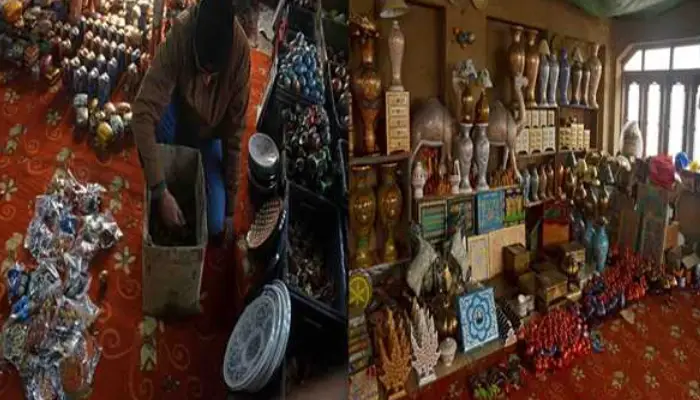
Srinagar, Dec 9 – Kashmir paper-mache art is seeing a ray of hope for revival. To make the papier- mache art more attractive the artisans are mixing Iranian or Persian artwork in their products which is adding a new life to these treasured handicraft varieties of Kashmir with people around the globe showing keen interest in buying these products.
32-year-old artisan Nayeem Mir, a resident of Zadibal area of downtown Srinagar running “Akhter Mir & Brothers” papier- mache factory said that earlier the art was limited to few design works including, Hazara (the thousand flowers) and Gulandar Gul (flower in flower) but since it has been mixed with Persian art with gold touch it has revived again in a big way.
Mir, who has completed his master’s in business administration (MBA), said earlier the papier -mache items from Kashmir were exported only to European countries during the Christmas festival. But after mixing the Iranian art with gold touch work it has found customers from the Middle East for the first time.
“We have received orders since last year from the Middle East, but this year it is very huge and of their choice. This year we have received 80 percent order only from the Middle East for the first time and 20 percent from Europe,” he added.
He said, but the Middle East people have put up the order as per their requirement.
“We have exported papier -mache balls, stars, moon sets and also made artwork of camels with the background of desert on Medium Density Fiberboard (MDF) to the Middle East as per their requirement”, he said.
He said papier -mache art has also started again finding its market in India and people instead of using Chinese or Ceramic products for decoration of their homes are now using papier -mache products which they feel are more attractive and eco-friendlier also.
People used to purchase wall hangings, flower vases and table lamps made of papier-mache to keep them in their homes for decoration.
Mir said in Kashmir a new trend has started for the past five years that people are using highly textured and well-crafted, designed and decorated papier -mache products as fruit serving boxes to the guests during the marriage ceremonies and it has given a new impetus to the art in a big way locally.
Moreover, the people use papier -mache art in making interior designs of their houses not only in Kashmir but other parts of the world also, he added.
He said the artists who were associated with the papier -mache could only look after their day-to-day meals earlier. But now with its news demand one can make good savings out of it every month.
National award winner Iqbal Khan said that Paper-mache art is flourishing day by day as orders are pouring from Europe and other countries during the Christmas season.
“We have received so many orders in Kashmir itself doing paper-mache work to the “Khatamband” ceilings of residential houses that has provided the craft a new lease of life”, Khan said and added “however, the manpower is very less available as new generation is hardly showing any interest towards the art”.
Director Handicrafts Mehmood Shah said that Paper-mache art work is also being done in hotel rooms to make them more attractive and tourists are showing their interest to take it to their homes.
“Yes, this is an encouraging trend that people are taking Paper-mache art “, he said and added “we are supporting artisans and providing them financial help”.
The papier-mache art is said to be brought to Kashmir by Persian Muslim Sufi scholar Mir Sayyid Ali Hamadani, in the 14th century and is a treasured handicraft variety of Kashmir. The process involves the application of paper pulp over wooden moulds and then meticulously painting the final shape with rich colours.
Paper-mache Arts and Craft items are being made by particular artisans of the people in Kashmir.
However, the art has been on decline as youngsters from the families involved in the craft are not interested to carry on the legacy due to lesser returns.






